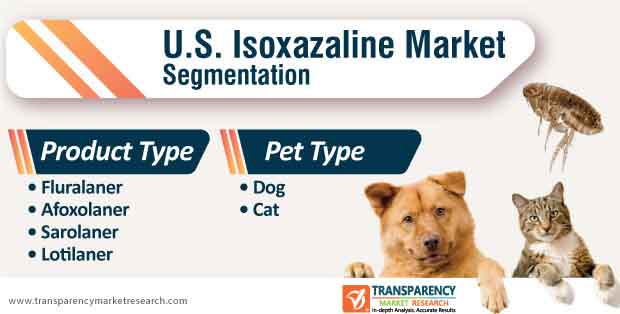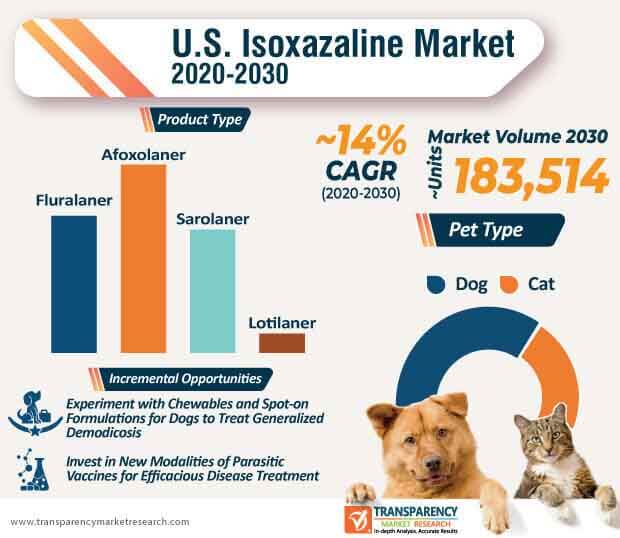The COVID-19 (coronavirus) pandemic-related mobility issues have led to pet owners stocking up on consumables and medications for their cats and dogs. Companies in the U.S. Isoxazoline market have strengthened their supply chains to tide over uncertainties in demand. According to latest veterinary news, the FDA (Food and Drug Administration) has approved a novel combination Isoxazoline parasite preventive for dogs in the U.S. This has created incremental opportunities for manufacturers in the U.S. Isoxazoline market.
Pharma companies are experiencing a decline in the demand for drugs and topical medications for pets. However, concerned pet owners are ensuring steady supply of drugs and medications from their insurance companies and suppliers. The awareness about standard precautionary measures for pets during the ongoing COVID-19 pandemic has fueled the demand for drugs and medications.

There is a high prevalence of generalized demodicosis or red mange in dogs. Ongoing investigations in Isoxazoline and a combination of imidacloprid and moxidectin are being debated in the field of parasitology. It has been found that Isoxazolines have a comparable efficacy over combination of imidacloprid and moxidectin. Fluralaner, sarolaner, and afoxolaner hold promising potentials in the treatment of generalized demodicosis in dogs. As such, afoxolaner is not only projected to hold a lion’s share, in terms of value, but its products are anticipated for exponential growth during the assessment period in the U.S. Isoxazoline market.
Companies in the U.S. Isoxazoline market are streamlining their production activities as per changing dosage frequencies for dogs. The severity of red mange among dogs is laying the basis for drug manufacturing.
The U.S. Isoxazoline market is predicted to expand at a favorable CAGR of ~14% during the forecast period. However, many pet owners are encountering drug resistance issues in their cats and dogs. This has triggered the need for novel resistance-breaking antiparasitics with new mechanisms/modes of action. Pharma companies must invest in new modalities pertaining to parasitic vaccines or environment-friendly interventions to increase the availability of efficacious treatments. Companies in the U.S. Isoxazoline market are increasing their R&D in oxime-participating cyclization strategy for the construction of efficacious compounds.
Apart from fluralaner and afoxolaner, companies in the U.S. Isoxazoline market are increasing their focus in sarolaner, which is found to be highly effective against ticks and fleas in dogs. Once a month administration of sarolaner is being recommended by veterinarians. The FDA approval of sarolaner is encouraging manufacturers in the U.S. Isoxazoline market to innovate in new drug formulations and topical solutions. For instance, Zoetis— one of the key producers of medicine and vaccinations for pets and livestock is gaining market recognition for developing sarolaner from azetidine-based Isoxazoline lead.
Pharma companies are increasing their production capacities in oral formulations for sarolaner, since topical formulations are typically washed off or licked off by dogs.
The U.S. Isoxazoline market is projected to exceed US$ 3.6 Bn by the end of 2030. This is evident since pharma companies are experimenting with chewables and spot-on formulations for the treatment of generalized demodicosis in dogs. This has created business avenues for manufacturers, since red mange is potentially challenging to cure with the help of traditional strategies.
On the other hand, companies in the U.S. Isoxazoline market are boosting clinical trials in lotilaner to assess its efficacy against adult cat flea. Even dogs are administered orally with lotilaner to prevent flea egg production. Reduced adverse events with lotilaner are being preferred by veterinarians and pet owners.

Analysts’ Viewpoint
The coronavirus has fueled the demand for antiparasitics induced with Isoxazoline, owing to awareness about standard precautionary measures from veterinarians and healthcare associations. The U.S. Isoxazoline market is anticipated to surpass the production of ~183,514 units by 2030. However, Isoxazoline medications for flea and tick are being linked with muscle tremors and seizures in cats and dogs. Hence, companies should conduct surveys and invest in novel drug formulations, and innovate with preventatives such as non-toxic flea shampoos and combs to overcome the issue of adverse events in pets. Manufacturers should increase their production capabilities in lotilaner tablets and sarolaner medications that are well-tolerated in cats and dogs.
U.S. Isoxazoline Market: Overview
Key Growth Drivers of U.S. Isoxazoline Market
Key Challenges for U.S. Isoxazoline Market
Lucrative Opportunities for Players in U.S. Isoxazoline Market
Leading Players in U.S. Isoxazoline Market
Isoxazoline Market is projected to reach US$ 3.6 Bn by the end of 2030
Isoxazoline Market is expected to grow at a CAGR of 30% during 2020-2030
Rise in penetration of eCommerce in the global pet industry is boosting the demand for tick repellent products
North America is a more attractive region for vendors in the Isoxazoline Market
Key vendors in the Isoxazoline Market are Merck Animal Health Inc., Elanco Animal Health Incorporated, Boehringer Ingelheim International GmbH, and Zoetis Inc. etc
1. Preface
1.1. Report Scope and Market Segmentation
1.2. Research Highlights
2. Assumptions and Research Methodology
2.1. Assumptions and Acronyms Used
2.2. Research Methodology
3. Executive Summary: U.S. Isoxazoline Market
3.1. Market Value, Indicative (US$ Mn)
3.2. Top Three Trends
4. Market Overview
4.1. Product Overview
4.2. Key Market Developments
4.3. Market Indicators
5. Market Dynamics
5.1. Drivers and Restraints Snapshot Analysis
5.1.1.1. Drivers
5.1.1.2. Restraints
5.1.1.3. Opportunities
5.2. Porter’s Five Forces Analysis
5.2.1. Threat of Substitutes
5.2.2. Bargaining Power of Buyers
5.2.3. Bargaining Power of Suppliers
5.2.4. Threat of New Entrants
5.2.5. Degree of Competition
5.3. Value Chain Analysis
6. U.S. Isoxazoline Market Volume (Thousand Units) and Value (US$ Mn) Analysis, by Product Type
6.1. Key Findings and Introduction
6.2. U.S. Isoxazoline Market Volume (Thousand Units) and Value (US$ Mn) Forecast, by Product Type, 2017–2030
6.2.1. Fluralaner
6.2.2. Afoxolaner
6.2.3. Sarolaner
6.2.4. Lotilaner
6.3. U.S. Isoxazoline Market Volume (Thousand Units) and Value (US$ Mn) Forecast, by Pet Type, 2017–2030
6.3.1. Dog
6.3.2. Cat
7. Competition Landscape
7.1. Company Profiles
7.1.1. Merck Animal Health Inc.
7.1.1.1. Company Description
7.1.1.2. Business Overview
7.1.1.3. Production Capacity
7.1.1.4. Siam Steel Galvanizing Factories List
7.1.1.5. Product Description
7.1.2. Boehringer Ingelheim International GmbH
7.1.2.1. Company Description
7.1.2.2. Business Overview
7.1.2.3. Production Capacity
7.1.2.4. Product Description
7.1.3. Zoetis Inc.
7.1.3.1. Company Description
7.1.3.2. Business Overview
7.1.3.3. Production Capacity
7.1.3.4. Product Description
7.1.4. Elanco Animal Health Incorporated
7.1.4.1. Company Description
7.1.4.2. Business Overview
7.1.4.3. Product Description
7.1.4.4. Financial Overview
8. Assumptions and Research Methodology
8.1. Report Assumptions
8.2. Secondary Sources and Acronyms Used
8.3. Research Methodology
List of Tables
Table 01: Number of U.S. Households That Own Pet, by Type of Animal (Million)
Table 02: U.S. Isoxazoline Market Value (US$ Mn) Forecast, by Product Type, 2019–2030
Table 03: U.S. Isoxazoline Market Volume (Thousand Units) Forecast, by Product Type, 2017–2030
Table 04: U.S. Isoxazoline Market Value (US$ Mn) Forecast, by Product Type, 2017–2030
Table 05: U.S. Isoxazoline Market Volume (Thousand Units) Forecast, by Pet Type, 2017–2030
Table 06: U.S. Isoxazoline Market Value (US$ Mn) Forecast, by Pet Type, 2017–2030
List of Figures
Figure 01: U.S. Isoxazoline Market Volume (Thousand Units) Forecast, by Product Type, 2019–2030
Figure 02: U.S. Isoxazoline Market Volume (Thousand Units) Forecast, by Pet Type, 2019–2030
Figure 03: U.S. Isoxazoline Pricing Analysis (US$/Units), by Product Type, 2019–2030